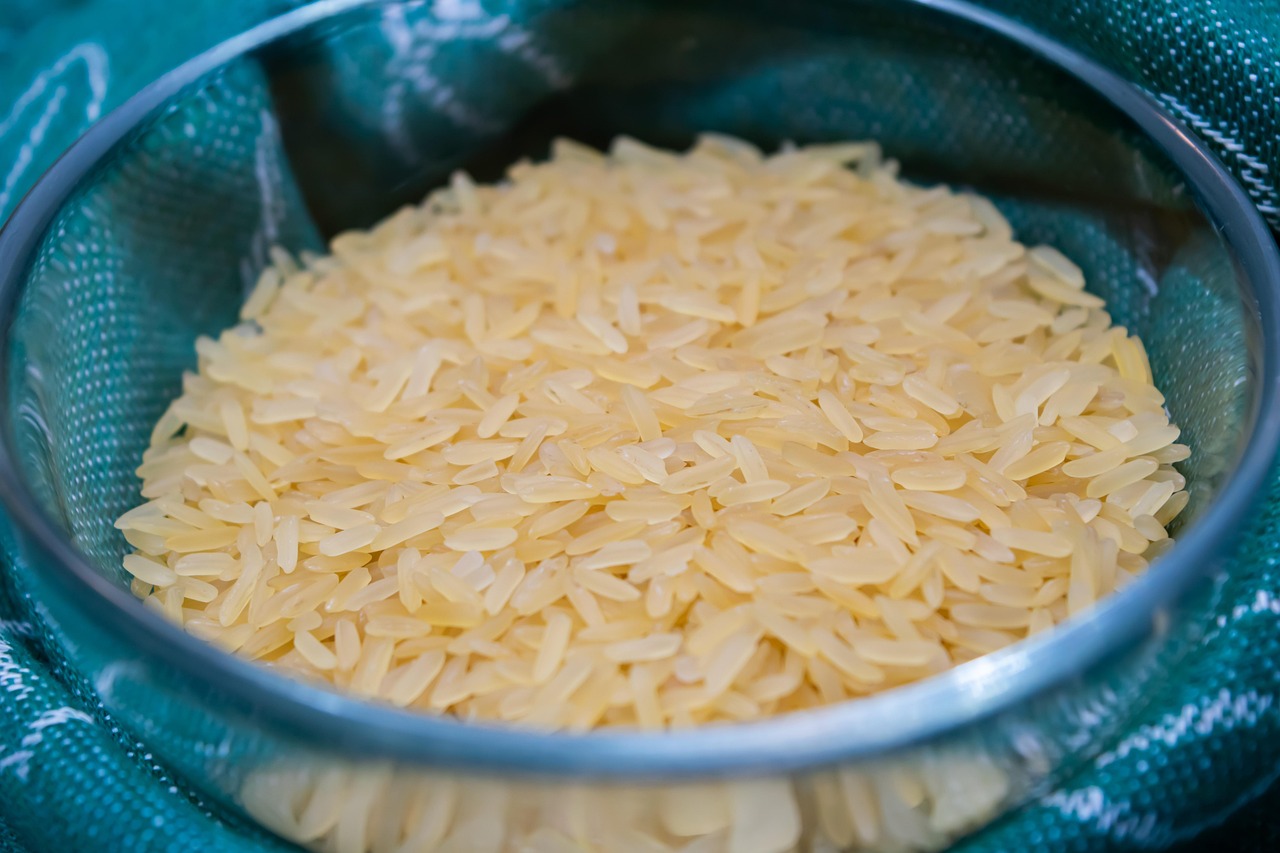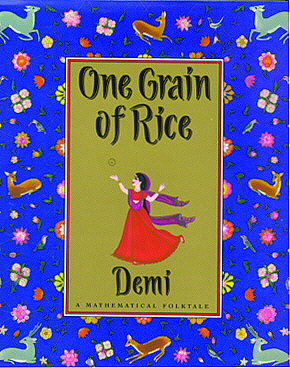More Than One Grain of Rice (Grades 3-5)
Students investigate the cultivation and identify the parts of rice by reading One Grain of Rice by Demi and removing the hull, bran, and germ from grains of rice.

Background
Lesson Activities
Recommended Companion Resources
Credits
Author
Debra Spielmaker | Utah Agriculture in the Classroom
Acknowledgements
Activity 3 was adapted from the California Foundation for Agriculture in the Classroom commodity fact sheet and activity sheet Rice.
Sources
- http://books.irri.org/9789712203008_content.pdf
- http://www.ers.usda.gov/topics/crops/rice/background.aspx
- http://www.ers.usda.gov/topics/crops/rice/trade.aspx
- https://cdn.agclassroom.org/ca/resources/fact/rice.pdf
Standards
Texas Content Area Standards
-
ELA: 3.110.5.b.6
Comprehension skills: listening speaking, reading, writing and thinking using multiple texts. The student uses metacognitive skills to both develop and deepen comprehension of increasingly complex texts.
- ELA: 3.6.G: The student is expected to evaluate details read to determine key ideas.
- ELA: 3.6.H: The student is expected to synthesize information to create new understanding.
- ELA: 3.6.I: The student is expected to monitor comprehension and make adjustments such as re-reading, using background knowledge, asking questions, and annotating when understanding break downs.
-
ELA: 3.110.5.b.7
Response skills: listening, speaking, reading, writing, and thinking using multiple texts. The student responds to an increasingly challenging variety of sources that are read, heard, or viewed.
- ELA: 3.7.G: The student is expected to discuss specific ideas in the text that are important to the meaning.
-
ELA: 4.110.6.b.1
Developing and sustaining foundational language skills: listening, speaking, discussion, and thinking- oral language. The students develops oral language through listening, speaking, and discussion.
- ELA: 4.1.D: The student is expected to work collaboratively with other to develop a plan of shared responsibilities.
-
ELA: 4.110.6.b.6
Comprehension skills: listening, speaking, reading, writing and thinking using multiple texts. The student uses metacognitive skills to both develop and deepen comprehension of increasingly complex texts.
- ELA: 4.6.G: The student is expected to evaluate details read to determine key ideas.
- ELA: 4.6.H: The student is expected to synthesize information to create new understanding.
- ELA: 4.6.I: The student is expected to monitor comprehension and make adjustments such as re-reading, using background knowledge, asking questions, and annotating when understanding break downs.
-
ELA: 4.110.6.b.7
Response skills: listening, speaking, reading, writing, and thinking using multiple texts. The student responds to an increasingly challenging variety of sources that are read, heard, or viewed.
- ELA: 4.7.G: The student is expected to discuss specific ideas in the text that are important to the meaning.
-
ELA: 5.110.7.b.1
Developing and sustaining foundational language skills: listening, speaking, discussion, and thinking- oral language. The students develops oral language through listening, speaking, and discussion.
- ELA: 5.1.D: The student is expected to work collaboratively with others to develop a plan of shared responsibilities.
-
ELA: 5.110.7.b.6
Comprehension skills: listening, speaking, reading, writing, and thinking using multiple texts. The student uses metacognitive skills to both develop and deepen comprehension of increasingly complex texts.
- ELA: 5.6.G: The student is expected to evaluate details read to determine key ideas.
- ELA: 5.6.H: The student is expected to synthesize information to create new understanding.
- ELA: 5.6.I: The student is expected to monitor comprehension and make adjustments such as re-reading, using background knowledge, asking questions, and annotating when understanding break downs.
-
ELA: 5.110.7.b.7
Response skills: listening, speaking, reading, writing, and thinking using multiple texts. The student responds to an increasingly challenging variety of sources that are read, heard, or viewed.
- ELA: 5.7.G: The student is expected to discuss specific ideas in the text that are important to the meaning.
-
Social Studies: 3.113.14.c.3
Geography. The student understands how humans adapt to and/or modify the physical environment. The student is expected to:
- Social Studies: 3.113.14.c.3.A: describe similarities and differences in the physical environment, including climate, landforms, natural resources, and natural hazards
-
Social Studies: 3.113.14.c.6
Economics. The student understands the concept of the free enterprise system and how businesses operate in the U.S. free enterprise system. The student is expected to:
- Social Studies: 3.113.14.c.6.A: explain how supply and demand affect the price of a good or service
- Social Studies: 3.113.14.c.6.B: define and identify examples of scarcity
-
Social Studies: 4.113.15.c.10
Economics. The student understands the characteristics and benefits of the free enterprise system in Texas. The student is expected to:
- Social Studies: 4.113.15.c.10.A: describe how the free enterprise system works, including supply and demand
-
Social Studies: 4.113.15.c.11
Economics. The student understands patterns of work and economic activities in Texas. The student is expected to:
- Social Studies: 4.113.15.c.11.A: explain how supply and demand affects consumers in the United States
- Social Studies: 4.113.15.c.11.B: evaluate the effects of supply and demand on industry and agriculture, including the plantation system, in the United States
-
Math: 3.111.5.b.4
Number and operations. The student applies mathematical process standards to develop and use strategies and methods for whole number computations in order to solve problems with efficiency and accuracy.
- Math: 3.4.A: The student is expected to solve with fluency one-step and two-step problems involving addition and subtraction within 1,000 using strategies based on place value, properties of operations, and the relationship between addition and subtraction.
- Math: 3.4.G: The student is expected to use strategies and algorithms, including the standard algorithm, the multiply a two-digit number by a one-digit number. Strategies may include mental mathm partial products, and the commutative, associative, and distributive properties.
- Math: 3.4.J: The student is expected to determine a quotient using the relationship between multiplication and division.
- Math: 3.4.K: The student is expected to solve one-step and two-step problems involving multiplication and division within 100 using strategies based on objects: pictorial models, including arrays, area models, and equal groups: properties of operation; or recall of facts.
-
Math: 4.111.6.b.4
Number and operations. The student applies mathematical process standards to develop and use strategies and methods for whole number computations in order to solve problems with efficiency and accuracy.
- Math: 4.4.A: The student is expected to add and subtract whole numbers and decimals to the hundredths place using the standard algorithm.
- Math: 4.4.D: The student is expected to use strategies and algorithms, including the standard algorithm, the multiply up to a four-digit number by a one-digit number and to multiply a two-digit number by a two-digit number. Strategies may include mental math, partial products, and the commutative, associative, and distributive properties.
- Math: 4.4.E: The student is expected to represent the quotient of up to a four-digit whole number divided by a one-digit whole number using arrays, area models, or equations.
- Math: 4.4.F: The student is expected to use strategies and algorithms, including the standard algorithm, to divide up to a four-digit dividend by a one-digit divisor.
- Math: 4.4.H: The student is expected to solve with fluency one-and two-step problems involving multiplication and division, including interpreting remainders.
-
Math: 5.111.7.b.3
Number and operations. The student applies mathematical process standards to develop and use strategies and methods for whole number computations in order to solve problems with efficiency and accuracy.
- Math: 5.3.B: The student is expected to multiply with fluency a three-digit number by a two-digit number using the standard algorithm.
- Math: 5.3.C: The student is expected to solve with proficiency for quotients of up to a four-digit dividend by a two-digit divisor using strategies and the standard algorithm.
- Math: 5.3.D: The student is expected to represent multiplication of decimals with products to the hundredths using objects and pictorial models, including area models.
- Math: 5.3.E: The student is expected to solve for products of decimals to the hundredths, including situations involving money, using strategies based on place-value understandings, properties of operations, and the relationship to the multiplication of whole numbers.
- Math: 5.3.K: The student is expected to add and subtract positive rational numbers fluently.
-
Science: 3.112.14.b.9
Organisms and environments. The student knows and can describe patterns, cycles, systems, and relationships within the environments.
- Science: 3.112.14.b.9.A: The student is expected to observe and describe the physical characteristics of environments and how they support populations and communities of plants and animals within an ecosystem.
-
Social Studies: 3.113.14.c.15
Social studies skills. The student communicates in written, oral, and visual forms. The student is expected to:
- Social Studies: 3.113.14.c.15.D: express ideas orally based on knowledge and experiences
-
Social Studies: 4.113.15.c.21
Social studies skills. The student communicates in written, oral, and visual forms. The student is expected to:
- Social Studies: 4.113.15.c.21.C: express ideas orally based on research and experiences
-
Social Studies: 5.113.16.c.25
Social studies skills. The student communicates in written, oral, and visual forms. The student is expected to:
- Social Studies: 5.113.16.c.25.C: express ideas orally based on research and experiences
